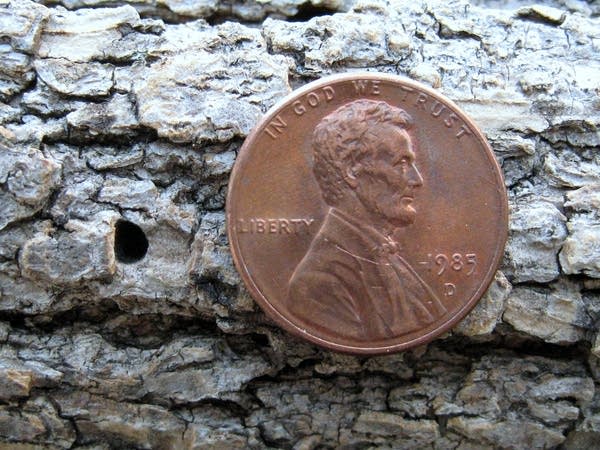Experts look for signs of ash borers' spread
Go Deeper.
Create an account or log in to save stories.
Like this?
Thanks for liking this story! We have added it to a list of your favorite stories.

It is a beautiful, sunny day near the the Mississippi River in St. Paul. In the shade along a riverfront parkway, it's easy to forget the danger that insect expert Jeffrey Hahn says could be lurking here.
Hahn, an entomologist with the University of Minnesota, is here with a small team, searching every ash tree for signs of the emerald ash borer. He points to a tree with suspicious symptoms.

"When you look at the top of the tree, you can see that the foliage is really thin, there are some dead branches. So it's been declining or something has been attacking it," Hahn said.
The symptoms are tough to spot and are easily mistaken for other problems. The bugs can live inside a tree undetected for years. That's why, Hahn says, his survey team is trying to get as close as they can.
Turn Up Your Support
MPR News helps you turn down the noise and build shared understanding. Turn up your support for this public resource and keep trusted journalism accessible to all.
"The other thing we have been looking for, too, are the D-shaped exit holes," he said. "They are hard to find and a lot of times they are up higher. There are plenty of instances where we have trees we know are infested and we can't find those exit holes, so that can be a challenge. But it's still worth looking because if you do find it, it is very diagnostic and definitive."
The holes are created as larvae tunnel through the bark, cutting off the trees' food supply. Starving a tree this way typically kills it within a few years.

Telltale signs include damaged bark, thinning leaves spreading out from the crown and woodpecker holes. Woodpeckers like to eat the bugs.
Since evidence of the emerald ash borer was found, teams like this one have been working their way across a two-mile radius around the infestation site. The goal is to get a sense of how serious and widespread it is. After that, experts will start mapping out a strategy for containing its spread.
But the emerald ash borer isn't easy to stop. From looking at the St. Paul infestation, experts estimate that the insect has already been here for about four years.
It is thought to have entered the U.S. in wooden shipping containers from Asia. Soon after it was discovered in Michigan, millions of ash trees died. Many were chopped down in an attempt to prevent the spread, but it was unsuccessful. The bug had already moved to other states, getting as far as Wisconsin.

That is, until now. And with more than 900 million ash trees in Minnesota, Department of Agriculture officials say it's critical to stop the infestation now. Ash trees are native to state forests and are very popular street trees.
"Crisis is not too strong of a word," said Hahn. He visited Michigan after the ash borer infestation there and says it was devastating to witness.
"A landscape just devoid of trees. I mean, entire neighborhoods lost essentially all their trees," he recalled. "It was nothing but a big field with a bunch of stumps."
Not far from the river, Jeff Chermak is shoveling sand to build a patio in the shade of a giant ash tree in his backyard. He says he is willing to do whatever it takes to save that tree, and another large ash, in his yard.

"If I thought I could prevent anything, then certainly I would cut them down tomorrow. But I don't think there is any prevention," Chermak said. "I think it is already here, so am I going to cut my trees down for no reason? I kind of enjoy them."
There's not much you can do to ward off the emerald ash borer. Native ash trees have no natural defense against them.
Some insecticides have been shown to work, and some experts recommend using them to protect large, established trees. They say it might not be worth the effort to try and save smaller ash trees.
For now, officials are asking people to avoid moving firewood between counties. The Department of Agriculture is also asking people not to move ash and other kinds of trees as a precaution.




